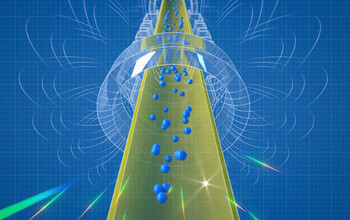Down goes antimatter! Gravity's effect on matter's elusive twin is revealed

An artist's rendering of antihydrogen atoms falling out the bottom of the ALPHA-g magnetic trap.
September 27, 2023
Landmark CERN experiment answers longstanding question of whether antimatter and matter are gravitationally attracted or repelled.
If you dropped some antimatter, would it fall down or up? Scientists now know the definitive answer: down. That is, if you can somehow prevent it from exploding into pure energy long enough to see where it goes.
A scientific paper describing the landmark experiment behind that conclusion is published today in the journal Nature and comes from the international Antihydrogen Laser Physics Apparatus (ALPHA) collaboration at the European Organization for Nuclear Research (CERN) in Switzerland. The ALPHA collaboration's unique, painstaking experiment has answered the longstanding fundamental question about whether antimatter is gravitationally attracted or repelled by regular matter by observing the downward path taken by individual atoms of antihydrogen. Their work also provides a key piece in one of the most immense unsolved puzzles in science — why is there so little antimatter in the observable universe?
CERN's ALPHA collaboration is supported by more than a dozen countries and private institutions, including the U.S. through the joint U.S. National Science Foundation/Department of Energy Partnership in Basic Plasma Science and Engineering program.
The U.S. National Science Foundation propels the nation forward by advancing fundamental research in all fields of science and engineering. NSF supports research and people by providing facilities, instruments and funding to support their ingenuity and sustain the U.S. as a global leader in research and innovation. With a fiscal year 2023 budget of $9.5 billion, NSF funds reach all 50 states through grants to nearly 2,000 colleges, universities and institutions. Each year, NSF receives more than 40,000 competitive proposals and makes about 11,000 new awards. Those awards include support for cooperative research with industry, Arctic and Antarctic research and operations, and U.S. participation in international scientific efforts.
Connect with us online
NSF website: nsf.gov
NSF News: nsf.gov/news
For News Media: nsf.gov/news/newsroom
Statistics: nsf.gov/statistics/
Awards database: nsf.gov/awardsearch/
Follow us on social
Twitter: twitter.com/NSF
Facebook: facebook.com/US.NSF
Instagram: instagram.com/nsfgov


